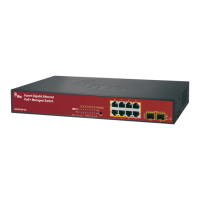information into the header of all packets that flow into those ports. If a
packet has previously been tagged, the port will not alter the packet, thus
keeping the VLAN information intact. The VLAN information in the tag can
then be used by other 802.1Q compliant devices on the network to make
packet-forwarding decisions.
• Untagged:
Ports with untagging enabled will strip the 802.1Q tag from all packets that
flow into those ports. If the packet doesn't have an 802.1Q VLAN tag, the
Frame Leave
Income Frame is tagged Income Frame is untagged
Leave port is tagged Frame remains tagged Tag is inserted
Leave port is
untagged
Tag is removed Frame remain untagged
Table 4-6-1 Ingress/Egress port with VLAN VID Tag/Untag table
■ IEEE 802.1Q Tunneling (Q-in-Q)
IEEE 802.1Q Tunneling (QinQ) is designed for service providers carrying traffic for multiple customers
across their networks. QinQ tunneling is used to maintain customer-specific VLAN and Layer 2 protocol
configurations even when different customers use the same internal VLAN IDs. This is accomplished by
inserting Service Provider VLAN (SPVLAN) tags into the customer’s frames when they enter the service
provider’s network, and then stripping the tags when the frames leave the network.
A service provider’s customers may have specific requirements for their internal VLAN IDs and number
of VLANs supported. VLAN ranges required by different customers in the same service-provider
network might easily overlap, and traffic passing through the infrastructure might be mixed. Assigning
a unique range of VLAN IDs to each customer would restrict customer configurations, require intensive
processing of VLAN mapping tables, and could easily exceed the maximum VLAN limit of 4096.

